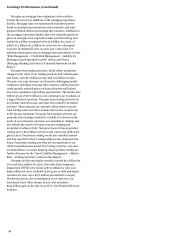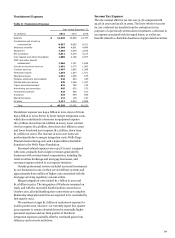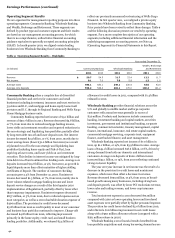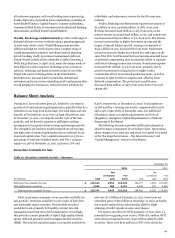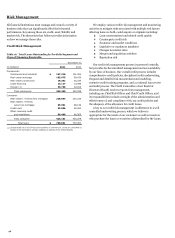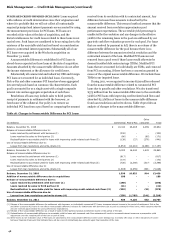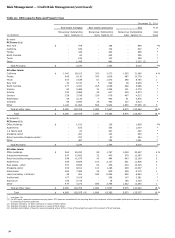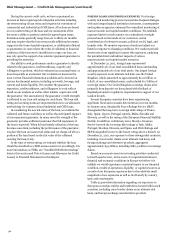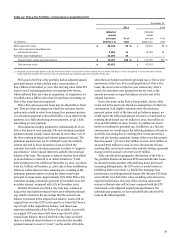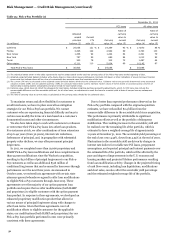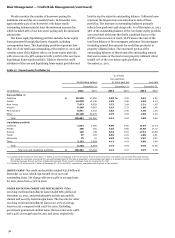Wells Fargo 2011 Annual Report Download - page 50
Download and view the complete annual report
Please find page 50 of the 2011 Wells Fargo annual report below. You can navigate through the pages in the report by either clicking on the pages listed below, or by using the keyword search tool below to find specific information within the annual report.
Risk Management — Credit Risk Management (continued)
PURCHASED CREDIT-IMPAIRED (PCI) LOANS
Loans acquired
with evidence of credit deterioration since their origination and
where it is probable that we will not collect all contractually
required principal and interest payments are accounted for using
the measurement provisions for PCI loans. PCI loans are
recorded at fair value at the date of acquisition, and the
historical allowance for credit losses related to these loans is not
carried over. Such loans are considered to be accruing due to the
existence of the accretable yield and not based on consideration
given to contractual interest payments. Substantially all of our
PCI loans were acquired in the Wachovia acquisition on
December 31, 2008.
A nonaccretable difference is established for PCI loans to
absorb losses expected on those loans at the date of acquisition.
Amounts absorbed by the nonaccretable difference do not affect
the income statement or the allowance for credit losses.
Substantially all commercial and industrial, CRE and foreign
PCI loans are accounted for as individual loans. Conversely,
Pick-a-Pay and other consumer PCI loans have been aggregated
into several pools based on common risk characteristics. Each
pool is accounted for as a single asset with a single composite
interest rate and an aggregate expectation of cash flows.
Resolutions of loans may include sales to third parties,
receipt of payments in settlement with the borrower, or
foreclosure of the collateral. Our policy is to remove an
individual PCI loan from a pool based on comparing the amount
received from its resolution with its contractual amount. Any
difference between these amounts is absorbed by the
nonaccretable difference. This removal method assumes that the
amount received from resolution approximates pool
performance expectations. The accretable yield percentage is
unaffected by the resolution and any changes in the effective
yield for the remaining loans in the pool are addressed by our
quarterly cash flow evaluation process for each pool. For loans
that are resolved by payment in full, there is no release of the
nonaccretable difference for the pool because there is no
difference between the amount received at resolution and the
contractual amount of the loan. Modified PCI loans are not
removed from a pool even if those loans would otherwise be
deemed troubled debt restructurings (TDRs). Modified PCI
loans that are accounted for individually are TDRs, and removed
from PCI accounting, if there has been a concession granted in
excess of the original nonaccretable difference. We include these
TDRs in our impaired loans.
During 2011, we recognized in income $239 million released
from the nonaccretable difference related to commercial PCI
loans due to payoffs and other resolutions. We also transferred
$373 million from the nonaccretable difference to the accretable
yield for PCI loans with improving credit-related cash flows and
absorbed $2.3 billion of losses in the nonaccretable difference
from loan resolutions and write-downs. Table 18 provides an
analysis of changes in the nonaccretable difference.
Table 18: Changes in Nonaccretable Difference for PCI Loans
Other
(in millions)
Commercial
Pick-a-Pay
consumer
Total
Balance, December 31, 2008
$
10,410
26,485
4,069
40,964
Release of nonaccretable difference due to:
Loans resolved by settlement with borrower (1)
(330)
-
-
(330)
Loans resolved by sales to third parties (2)
(86)
-
(85)
(171)
Reclassification to accretable yield for loans with improving credit-related cash flows (3)
(138)
(27)
(276)
(441)
Use of nonaccretable difference due to:
Losses from loan resolutions and write-downs (4)
(4,853)
(10,218)
(2,086)
(17,157)
Balance, December 31, 2009
5,003
16,240
1,622
22,865
Release of nonaccretable difference due to:
Loans resolved by settlement with borrower (1)
(817)
-
-
(817)
Loans resolved by sales to third parties (2)
(172)
-
-
(172)
Reclassification to accretable yield for loans with improving credit-related cash flows (3)
(726)
(2,356)
(317)
(3,399)
Use of nonaccretable difference due to:
Losses from loan resolutions and write-downs (4)
(1,698)
(2,959)
(391)
(5,048)
Balance, December 31, 2010
1,590
10,925
914
13,429
Addition of nonaccretable difference due to acquisitions
188
-
-
188
Release of nonaccretable difference due to:
Loans resolved by settlement with borrower (1)
(198)
-
-
(198)
Loans resolved by sales to third parties (2)
(41)
-
-
(41)
Reclassification to accretable yield for loans with improving credit-related cash flows (3)
(352)
-
(21)
(373)
Use of nonaccretable difference due to:
Losses from loan resolutions and write-downs (4)
(258)
(1,799)
(241)
(2,298)
Balance, December 31, 2011
$
929
9,126
652
10,707
(1)
Release of the nonaccretable difference for settlement with borrower, on individually accounted PCI loans, increases interest income in the period of settlement. Pick-a-Pay
and Other co
nsumer PCI loans do not reflect nonaccretable difference releases for settlements with borrowers due to pool accounting for t
hose loans, which assumes that the
amount received approximates the pool performance expectations.
(2)
Release of the nonaccretable difference as a result of sales to third parties increases noninterest income in the period of the sale.
(3)
Reclassification of nonaccretable difference to accretable yield for loans with increased cash flow estimates will result in increased interest income as a prospective yield
adjustment over the remaining life of the loan or pool of loans.
(4)
Write-downs to net realizable value of PCI loans are absorbed by the nonaccretable difference when severe delinquency (normally 180 days) or other indications of severe
borrower financial stress exist that indicate there will be a loss of contractually due amounts upon final resolution of the loan.
48


